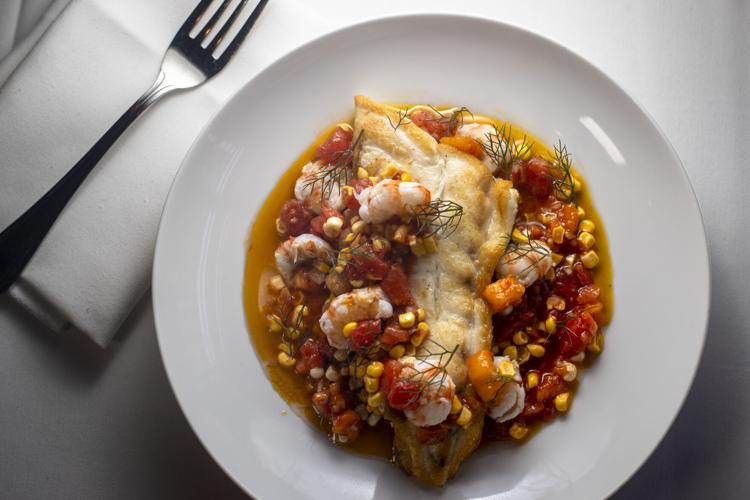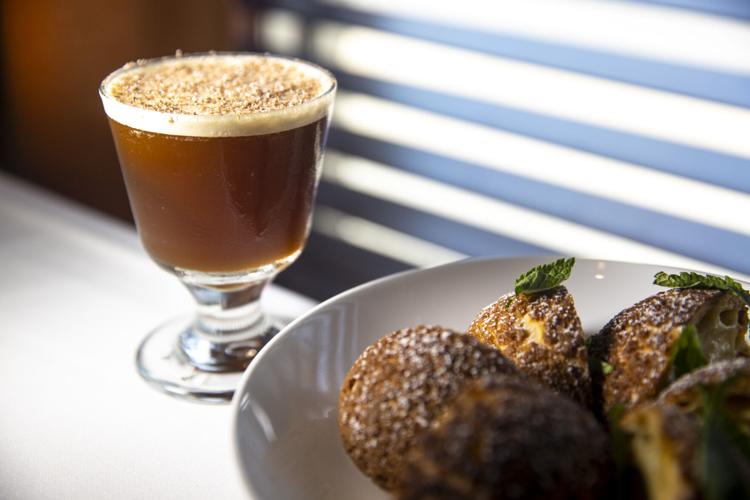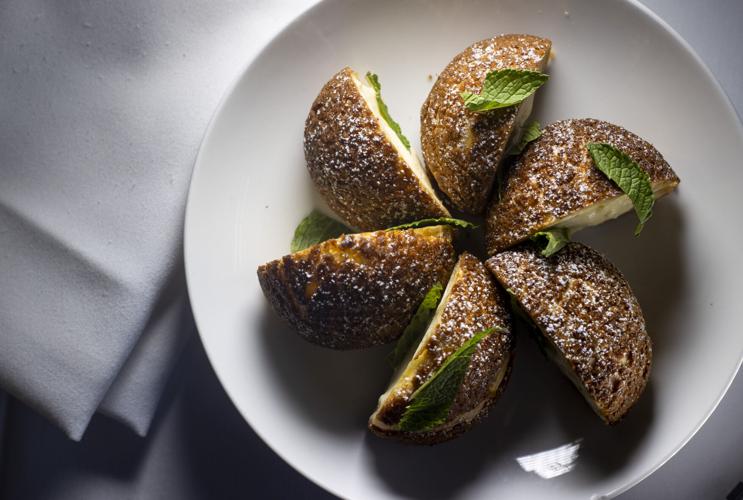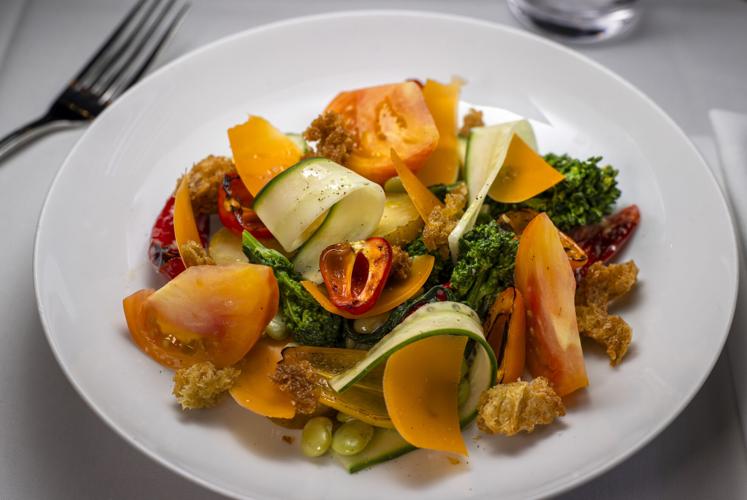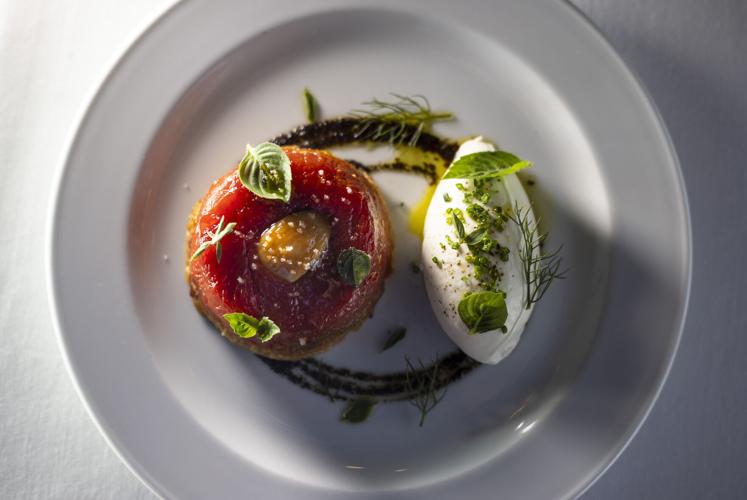FIG celebrated its 20th anniversary in April, a milestone few fine dining restaurants reach. For most of those two decades, it’s been on almost every list of Charleston’s must-visit restaurants.
But times change, and dining trends shift. With so many old favorites departing in recent years and new players arriving on the scene, it seemed time to return to FIG and see how it is holding up.
Some things haven’t changed a bit, and they don’t need to. The chicken liver pâté ($19) is as brilliant as ever. The rosy pink slab is rimmed in an almost impossibly thin border of white pork fat, so prim and precise that it looks almost like a photographer’s prop. Silky smooth and ethereally light, each bite almost melts on the tongue, finishing with a dark, earthy kiss.

The Nine Vegetable Salad a classic caesar, with mimolette, and croutons from FIG in downtown Charleston. Andrew J. Whitaker/Staff
The nine vegetable salad ($19) remains a menu fixture, too. I suspect it may actually contain more than nine vegetables. (I lost count around seven, and I’m not sure whether to include the delightful chunks of boiled potato.) At its core, it’s a classic Caesar salad, with creamy, garlic-tinged dressing enrobing a few slips of romaine and crisp crouton crumbles.
But then every spare veggie in the kitchen gets invited to the party — limas, cherry tomatoes, broccolini — the colorful assemblage is cool and fresh. One contrasting texture comes fast on the heels of another — the cool crunch of cucumber, then a prickly spark of pickled red onion, then a creamy punch from a shaving of orange Mimolette cheese.
Those old hits still shine, but there’s plenty of excitement in the newer catalog, too. The cantaloupe with sherry sabayon ($16) is a genre-bending dish. Is it an appetizer? A dessert? Does it matter? The riot of flavors really shouldn’t work together, but they undeniably do. A long slice of cool, mildly sweet melon is blanketed with a creamy white sabayon. Rivulets of brown butter add salty caramel notes, and a scattering of pine nuts offers a fragrant finishing crunch.
When Mike Lata and Adam Nemirow opened FIG in 2003, they wanted to be iconoclastic. There would be no walk-in refrigerator, much less a freezer. At a time when most fine dining restaurants were serving grouper imported from Thailand and tomatoes and asparagus in the dead of winter, Lata offered a small menu that changed daily, driven by whatever fish and produce local purveyors brought in the back door. Nemirow brought a similar philosophy to the wine list, bypassing the big distributors and offering a highly-curated selection from small producers.
The two opened FIG on a shoestring in a former pizza joint just two blocks from the City Market. The focus was squarely on the food, not fine dining trappings. They aimed to create the kind of place where guests would be comfortable in jeans and a sweater but still have a phenomenal meal.
Food remains the center of the equation, but much has changed over the years. A series of remodels overhauled the kitchen, put new floors and paint in the dining room and brought in proper chairs that all match. The early idealism was tempered by practicality. Lata added a walk-in fridge, and he shifted to a menu that evolves week-to-week and employs recurring preparations into which different main ingredients can be plugged.

The dinning room at FIG in downtown Charleston. Andrew J. Whitaker/Staff
One recent set piece takes a roasted filet of the day’s white fish — B-liner snapper, gag grouper, golden tile — and presents it with sweet corn and rock shrimp in a simple sauce vierge. It was red snapper ($44) the night I tried it. Something about the spare, reddish-orange sauce seems odd at first bite — too thin, perhaps, and lacking that rich surge of butter our taste buds have come to expect.
But on the next bite there’s a chunk of brightly acidic summer tomato followed by the sweet pop of yellow corn and then the even sweeter and more delicate shrimp. A mildly smooth layer of good olive oil binds it all together, and that turns out to be all the support that such pure, fresh ingredients need.
The preparation reflects FIG’s core culinary aesthetic: take top-quality ingredients (especially fresh local vegetables and seafood) and treat them simply. There’s no better example of that than a side dish of okra ($12), which is exquisitely spartan. A dozen or so full-length spears get nothing more than a generous kiss of salt as they’re flipped in a cast iron skillet, and they end up perfectly tender, not a bit gooey, and striped with delightful black char. They’re plated simply, too — stacked like cordwood on a plain white plate and sprinkled with sea salt.

Skillet okra at FIG in downtown Charleston. Andrew J. Whitaker/Staff
There is, however, an oval pool of pale yellow béarnaise spooned alongside. Splendidly creamy and fragrant, it suggests things aren’t quite as simple as they seem on first glance.
Plenty of artifice goes into dishes like the chicken al mattone ($39), which is almost postmodern in conception. It looks almost like a rectangular slice of lasagna but with compressed and succulently roasted chicken breast in place of the pasta and broad, thin slices of chilled heirloom tomato crowning the top. It’s plated over a pool of thin brown jus dappled with yellow oil and finished in a somewhat deconstructed manner, with green dabs of pesto plus some of the sauce’s components — basil leaves and pinenuts — sprinkled over the top.
A bavette steak (a.k.a. sirloin flap, $49) is seared in a cast iron pan and carved into tender slices with a big beefy punch. They’re topped with hearty chestnut mushroom conserva and nestled beside a dome of absurdly smooth and buttery Yukon gold potato purée. That purée, if you don’t order the steak, is a fixture on the short slate of side dishes, too ($14).
FIG was farm-to-table before farm-to-table was cool and remains so today, even if that term is on the outs. They don’t make a big deal about it, though. No purveyors’ names appear on the menu, and they certainly aren’t inscribed on the wall, but the menu makes full use of the region’s fresh, seasonal bounty.
The sauces and accents that adorn that bounty — brown butter, bordelaise, romesco, béarnaise — hew toward the classic, and though intensely flavored they’re consistently applied with a light touch. It was only later, when looking over a few recent menus, that I was struck by what wasn’t to be found. There’s no chili crisp and no furikake, no upscale spins on General Tso’s sauce, no Nashville hot anything.

The vine ripe tomato tarte tatin at FIG in downtown Charleston. Andrew J. Whitaker/Staff
Still, nothing seems out of date. The bouillabaisse ($44) is flawless, with chunks of white fish and tender shrimp nestled amid a cloudy broth, the yellow surface spattered with oil. The dark herbal flavors of tarragon and fennel surge through each bite, and, in a deft Lowcountry spin, some decidedly non-traditional butter beans and tender grains of brown rice are tucked inside the splendid broth. A thin, cracker-crisp slice of toast comes alongside with florets of bright yellow rouille piped on top. Break off a shard and drop it into the broth, and the saffrony, garlicky crunch puts the whole thing over the top.
Do I have any gripes about FIG as it eases into its third decade? I could dredge one up if I had to. The cocktails, for instance, whether you are sitting in the dining room or up at the short bar, can take what seems sweet forever to arrive. Once delivered, though, all is forgiven, for the fantastic blends align perfectly with the restaurant’s overall aesthetic.
The Monday Blues ($16) is ironically named (the restaurant isn’t open on Mondays), and the slightly tart, slight sweet flavor of fresh blueberries shines through a base of tequila and floral St. Germain. The South Paterson ($18) puts a smooth twist on the Manhattan with chocolate bitters and rye whiskey fat-washed with pistachio brown butter, which imparts a dark, nutty sweetness. A similar washing with sesame adds even nuttier layers to the Suntory Time ($16), a whiskey sour made with Japanese Toki and Madeira wine and garnished with three delicious pickled edamame beans on a silver pick.

Jiminy Cricket after dinner cocktail at FIG with 16 Ron Zacapa Sistema 23 rum, Giffard Piment D’Espelette, espresso, Boomsma, peppermint, chocolate. Andrew J. Whitaker/Staff
The cocktail program at FIG, in other words, is top-shelf. It carries right through to the dessert menu, which features a splendidly murky concoction called the Jiminy Cricket ($16) that kicks things up with a dose of espresso and chile liqueur, tamps them down with Ron Zacapa 23 rum, and steers to a bittersweet finish with chocolate, peppermint and bitter Boomsma liqueur.
I can’t think of a better sip to enjoy alongside an order of lime cream puffs ($9) — three domes of dark-baked choux au craquelin piped full of tangy lime cream then sliced in half and arranged in a neat pinwheel with a few mint leaves for garnish.
The food at FIG has been dialed in for a long time, and the wine program has been top flight for almost as long. Now, 20 years in, all the other elements seem finely calibrated, too.
The most recent remodel in 2021 created what is now one of my favorite dining rooms in the city, elegant and serene but comfortable and inviting, too. Amid deep burgundy walls, the tables are well-spaced, leaving ample room between neighbors. A trio of gigantic mirrors, hung at a sloping angle on the back wall, create the illusion of even more open space. Even as the room fills, it’s never so loud that you have to strain to hear your tablemates speak.
As the once-iconoclastic FIG grew more formal, the fine dining scene around it tilted in a more casual direction. The result is a fine meeting in the middle. It’s refreshing to sit at a table clad in creased white linen. The china is all-white, and a spray of flowers in a small brown bottle is the only adornment on the table.
The service strikes the right balance between friendly and formal, too. Servers are kitted with crumb scrapers, and between courses every plate and fork is whisked away and replaced. Water glasses are topped off from an ice-filled metal pitcher, a white cloth napkin tied around the mouth to catch condensation. That water is wonderfully cold, too. These are small but unfortunately rare things in downtown restaurants these days.

From the dessert menu the lime cream puffs at FIG in downtown Charleston. Andrew J. Whitaker/Staff
Perhaps the most significant stage in FIG’s evolution came just over a decade ago, when Lata and Nemirow opened their second restaurant, The Ordinary. In March 2014, Jason Stanhope was elevated to become FIG’s executive chef. Just a year later he took home the James Beard Award for Best Chef Southeast, an honor that Lata himself had won in 2009.
The last time I took a seat in that elegant red dining room, I didn’t realize that the staff had been told just before service began that Stanhope would be departing after 15 years in the kitchen. This will, I am sure, open a new chapter in the restaurant’s story, but I don’t foresee many radical changes in the months ahead, just continued evolution.
A prime-hour table at FIG is still among the hardest to secure in town, and I don’t expect that to change, either. With two decades under its belt, the restaurant is firing on all cylinders, and the food remains as impressive and relevant as ever.
FIG has always been on my short list of the city’s must-visit fine dining restaurants. Now, it’s at the very top.

